Chorizo
Chorizo (/tʃəˈriːzoʊ, -soʊ/,[2][3] from Spanish [tʃoˈɾiθo]) or chouriço (from Portuguese [ʃo(w)ˈɾisu]) is a type of pork sausage.
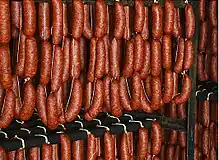 Curing chorizos | |
| Course | Sausage |
|---|---|
| Place of origin | Spain[1] and Portugal |
| Region or state | Iberian Peninsula, Latin America, parts of Asia |
| Serving temperature | Hot or room temperature |
| Main ingredients | Pork, paprika |
In Europe, chorizo is a fermented, cured, smoked sausage, which may be sliced and eaten without cooking, or added as an ingredient to add flavor to other dishes. Elsewhere, some sausages sold as chorizo may not be fermented and cured, and require cooking before eating. Spanish chorizo and Portuguese chouriço get their distinctive smokiness and deep red color from dried, smoked, red peppers (pimentón/pimentão).[4]
Chorizo is eaten sliced in a sandwich, grilled, fried, or simmered in liquid, including apple cider or other strong alcoholic beverages such as aguardiente. It is also used as a partial replacement for ground (minced) beef or pork.[5]
Names
The word chorizo probably comes from the Late Latin salsīcia 'salted', via the Portuguese souriço; it is a doublet of the Spanish word salchicha 'sausage', which was transmitted through Italian salsiccia.[6][7]
In English, chorizo is usually pronounced /tʃəˈriːzoʊ, -soʊ/,[8] though sometimes the Castilian Spanish [θ] sound is used: /tʃəˈriːθoʊ/.
Pronunciation and spelling vary slightly among the Iberian languages:
- Astur-Leonese: chorizu [tʃoˈɾiθu]
- Basque: txorizo [tʃoˈɾis̻o]
- Catalan: xoriço [ʃuˈɾisu]
- Galician: chourizo [tʃowˈɾiθʊ]
- Portuguese: chouriço [ʃo(w)ˈɾisu]
- Spanish: chorizo [tʃoˈɾiθo], [tʃoˈɾiso]
Varieties by region
Spain
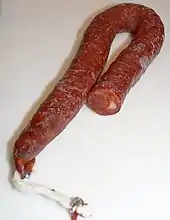
Spanish chorizo is made from coarsely chopped pork and pork fat, seasoned with garlic, pimentón – a smoked paprika – and salt. It is generally classed as either picante (spicy) or dulce (sweet), depending upon the type of pimentón used. Hundreds of regional varieties of Spanish chorizo, both smoked and unsmoked, may contain herbs, and other ingredients.[9] For example, chorizo de Pamplona is a thicker sausage with the meat more finely ground. Among the varieties is chorizo Riojano from the La Rioja region, which has PGI protection within the EU.
Chorizo is made in short or long and hard or soft varieties; leaner varieties are suited to being eaten at room temperature as an appetizer or tapas, whereas the fattier versions are generally used for cooking.[10] A rule of thumb is that long, thin chorizos are sweet, and short chorizos are spicy, although this is not always the case.[11]
Spain produces many other pork specialties, as well, such as lomo embuchado or salchichón, cured and air-dried in a similar way. Lomo is a lean, cured meat to slice, made from the loin of the pig, which is marinated and then air-dried. Salchichón is another cured sausage without the pimentón seasoning of chorizo, but flavoured with black peppercorns, instead.[12]
Depending on the variety, chorizo can be eaten sliced without further cooking, sometimes sliced in a sandwich, or grilled, fried, or baked alongside other foodstuffs, and is also an ingredient in several dishes where it accompanies beans, such as fabada or cocido montañés.
The version of these dishes con todos los sacramentos (with all the trimmings, literally sacraments) adds to chorizo other preserved meats such as tocino (cured bacon) and morcilla (blood sausage).
Portugal
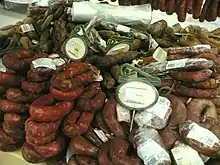
Portuguese chouriço or chouriça, is made (at least) with pork, fat, wine, paprika, garlic, hot pepper and salt. It is then stuffed into natural casings from pig or lamb and slowly dried over smoke.[13] The many different varieties differ in color, shape, spices and taste. White pepper, piri-piri, cumin and cinnamon are a common addition. The Portuguese variety tends to be hotter than the Spanish. Many dishes of Portuguese and Brazilian cuisine make use of chouriço, including cozido à portuguesa and feijoada.[14][15]
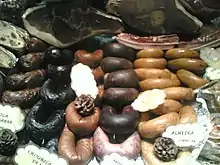
A popular way to prepare chouriço is slicing it part-way through and cooking it over an alcohol flame at the table (chouriço à bombeiro)[16] in purpose-made glazed earthenware dishes with a lattice top.
In Johannesburg, South Africa, the many Portuguese immigrants in the 1960s from Portugal and Mozambique tended to settle in a suburb called La Rochelle (Little Portugal).[17] Most of them either returned to Portugal or moved on to more affluent suburbs in the city, but restaurants in the area and the very well-supported annual "Lusitoland" fundraiser festival have chouriço on the menu.[18]
In the heavily Portuguese counties in the US states of Rhode Island and southeastern Massachusetts, chouriço is often served with little neck clams and white beans.[19] Chouriço sandwiches on grinder rolls, with sautéed green peppers and onions, are commonly available at local delis and convenience stores. Stuffed quahogs (also known as stuffies), a Rhode Island specialty, usually include chouriço.[20]
In Portugal a blood sausage similar to black pudding is called chouriça de sangue (blood chouriço). Other types of chouriço include chouriça de vinho, chouriço de cebola, chouriço fumado, chouriço de ossos, chourição and chouriça de vinha d’alho.
Mexico

Based on the uncooked Spanish chorizo fresco (fresh chorizo), the Mexican versions of chorizo are made not just from fatty pork, but also from beef, venison, chicken, turkey, and even tofu, kosher, and vegan versions are made. The meat is usually ground (minced) rather than chopped, and different seasonings are used. This type is better known in Mexico and other parts of the Americas, including the border areas of the United States, and is not frequently found in Europe. Due to culinary tradition and the high cost of imported Spanish smoked paprika, Mexican chorizo is usually made with native chili peppers of the same Capsicum annuum species, making it spicier than Spanish and Portuguese varieties of the sausage. Mexican longaniza are typically longer and spicier than chorizo.[21]
Spanish-American cuisine adds vinegar instead of the white wine usually used in Spain.
.JPG.webp)

The area around Toluca specializes in "green" chorizo, made with some combination of tomatillo, cilantro, chili peppers, and garlic. Most Mexican chorizo is a deep reddish color, and is largely available in two varieties, fresh and dried, though fresh is much more common.[22] Some of the cheapest commercial chorizos use offal stuffed in inedible plastic casing to resemble sausage links, rather than muscle meat. Before consumption, the casing is usually cut open and the sausage is fried in a pan and mashed with a fork until it resembles finely minced ground beef. A common alternative recipe does not have casings. Pork and beef are cured overnight in vinegar and chili powder. Served for breakfast, lunch, or dinner, it has the finely minced texture mentioned above, and is quite intense in flavor.
In Mexico, restaurants and food stands make tacos, queso fundido (or choriqueso), burritos, and tortas with cooked chorizo, and it is also a popular pizza topping. Chorizo con huevos is a popular breakfast dish in Mexico and areas of the United States with Mexican populations. It is made by mixing fried chorizo with scrambled eggs. Chorizo con huevos is often used in breakfast burritos, tacos, and taquitos. Another popular Mexican recipe is fried chorizo combined with pinto or black refried beans. This combination is often used in tortas as a spread, or as a side dish where plain refried beans would normally be served. In Mexico and the southwestern United States chorizo is also used to make chorizo con queso (or choriqueso), a popular appetizer consisting of small pieces of chorizo served with melted cheese and eaten with small corn tortillas or tortilla chips. In heavily Mexican parts of the United States, a popular filling for breakfast tacos is chorizo con papas, or diced potatoes sautéed until soft with chorizo mixed in.
Central America and the Caribbean
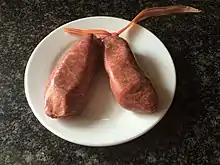
In Puerto Rico, Panama, and the Dominican Republic, chorizo and longaniza are considered two different types of meat. Puerto Rican chorizo is a smoked, well-seasoned sausage nearly identical to the smoked versions in Spain. Puerto Rican and Dominican longanizas have a very different taste and appearance. The seasoned meat is stuffed into a pork casing and is formed very long by hand. It is then hung to air-dry. Longaniza can then be fried in oil or cooked with rice or beans. It is eaten with many different dishes.
Salvadorean chorizo is short, fresh (not dried) and tied in twins.
South America
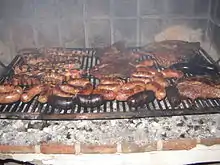
In Ecuador, many types of sausage have been directly adopted from European or North American cuisine. All sorts of salami, either raw or smoked, are known just as salami. Most commonly known are sorts from Spanish chorizo, Italian pepperoni, and wiener sausages; wieners are the most popular. Some local specialities include morcilla, longaniza, and chorizo. Morcilla, as in most Spanish-speaking countries, is basically cooked pork blood encased in pork intestine casing (black pudding in English). Longaniza is a thin sausage containing almost any mixture of meat, fat, or even cartilage, smoked rather than fresh. Chorizo is a mixture of chopped pork meat, pork fat, salt, whole pepper grains, cinnamon, achiote, and other spices, which produce its characteristic deep red color. A traditional dish consists of fried egg, mashed potatoes, avocado, salad, and slices of fried chorizo.
In Argentina,[23] Uruguay, Bolivia, Peru, Colombia and Venezuela, chorizo is the name for any coarse meat sausage. Spanish-style chorizo is also available, and is distinguished by the name "chorizo español" (Spanish chorizo). Argentine chorizos are normally made of pork, and are not spicy hot. Some Argentine chorizos include other types of meat, typically beef. In Argentina, Bolivia, Paraguay, Uruguay, Chile, and Peru, fresh chorizo, cooked and served in a bread roll, is called a choripán. In Colombia, chorizo is usually accompanied by arepa.
In Brazil, chouriço is the word used for what in the rest of Latin America is morcilla; meat sausages similar to the chorizos of other Latin American countries are called linguiça. Many varieties of Portuguese-style chouriço and linguiça are used in many different types of dishes, such as feijoada.
In Bolivia, chorizos are made of pork, fried and served with salad (tomato, lettuce, onion, boiled carrots and quirquiña), mote, and a slice of bread soaked with chorizo fat. Chorizo sandwiches, without mote, are also eaten.
East Timor
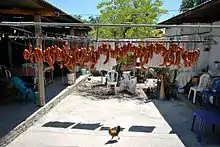
Chouriço is made in East Timor. It was introduced by the Portuguese, with their colonization of East Timor.
Goa

In Goa, India, which was ruled by the Portuguese for 450 years and has a large percentage of Goan Catholics, chouriço is made from pork marinaded in a mixture of vinegar, red chilies, and spices such as garlic, ginger, cumin, turmeric, cloves, pepper, and cinnamon, which is stuffed into casings.[24] These are enjoyed either with the local Goan Portuguese-style crusty bread, or pearl onions, or both. They are also used, cut into chunks, as the meat ingredient in rice pilaf. They can be raw (wet), smoked or cured through salting and air-drying.
Three kinds of chouriço are found in Goa: dry, wet, and skin. Dry chouriço is aged in the sun for long periods (three months or more). Wet chouriço has been aged for about a month or less. Skin chouriço, also aged, is rare and difficult to find. It consists primarily of minced pork skin along with some of its subcutaneous fat. All three chouriços are made in variations such as hot, medium, and mild. Other variations exist, depending on the size of the links, which range from 1 in (smallest) to 6 in. Typically, the wet varieties tend to be longer than the dry ones.
Goan chorizo should be distinguished from "Goan frankfurters", which look similar to equivalents in the United States, but with a predominantly peppercorn flavor.
Philippines

Longaniza (Tagalog: longganisa; Visayan: chorizo, choriso, soriso) are Philippine chorizos flavored with indigenous spices, and may be made of chicken, beef, or even tuna. While the term longaniza refers to fresh sausages, it is also used in the Philippines to refer to cured sausages. Philippine longganisa are often dyed red with achuete seeds. There are dozens of variants from various regions in the Philippines.[25]
United States
In comparison to Spanish chorizo, in the United States the term generally refers to a sausage that is never dried, has a fattier filling, and is very spicy. It is most popular near the Mexican border, especially in the Southwest near Chihuahua, Sonora, and Nuevo Leon. It is also found further north in places like Austin, Texas or Santa Fe, New Mexico, where its earliest evidence dates to well before the Wild West.[26][27] It is most commonly eaten for breakfast on its own, or mixed with a local version of migas.[28]
Louisiana
Creole and Cajun cuisine both feature a variant of chorizo called chaurice, which is frequently used in the Creole dish of red beans and rice.[29] As with its cousin to the west, smoking this variant is an acceptable practice in local cuisine.
References
- Lois, A. L.; Gutiérrez, L. M.; Zumalacárregui, J. M.; López, A. (1987). "Europe PMC". Meat Science. 19 (3): 169–77. doi:10.1016/0309-1740(87)90054-4. PMID 22055940.
- "Definition of CHORIZO". www.merriam-webster.com.
- "CHORIZO | meaning in the Cambridge English Dictionary". dictionary.cambridge.org.
- Tara Morgan (15 June 2015). "From Choricero to Chorizo: The Rare Pepper that Makes Traditional Basque Sausage Sing | Edible Idaho". Edibleidaho.ediblefeast.com. Retrieved 18 November 2016.
- Predika, Jerry (1983). The Sausage-making Cookbook. Harrisburg, PA: Stackpole Books. p. 32. ISBN 978-0-8117-1693-2.
- "Etimología de Chorizo", deChile.net s.v.
- Oxford English Dictionary, 1st edition, 1910, s.v. 'sausage'
- "Chorizo | Definition of Chorizo by Merriam-Webster". Merriam-webster.com. Retrieved 18 November 2016.
- "Archived copy". Archived from the original on 15 September 2008. Retrieved 2008-09-14.CS1 maint: archived copy as title (link)
- Trutter, Marion (2010). Culinaria Spain. Hf Ullmann. p. 343. ISBN 978-0841672277.
- Aris, Pepita (2003). Spanish: over 150 mouthwatering step-by-step recipes. London: Hermes House. pp. 54–55. ISBN 0681304006.
- "Archived copy". Archived from the original on 12 May 2015. Retrieved 2015-08-06.CS1 maint: archived copy as title (link)
- Santos, Nina. "A Guide to Portugal's Different Sausages". Culture Trip.
- Poelzl, Volker (15 October 2009). CultureShock! Portugal: A Survival Guide to Customs and Etiquette. ISBN 9789814435628.
- Esposito, Shaylyn. "How to Make Feijoada, Brazil's National Dish, Including a Recipe From Emeril Lagasse". Smithsonian Magazine.
- "Chouriço à Bombeiro (Flame Grilled Chouriço)". Easyportugueserecipes.com. 11 August 2015. Retrieved 11 October 2016.
- Abundant Portuguese Residents Elude The South African Census, The New York Times, May 29, 1981
- "Lusito Land Festival announces mouth-wateringly blissful menus". iloveza.com.
- Long, Lucy M. (17 July 2015). Ethnic American Food Today: A Cultural Encyclopedia. Rowman & Littlefield. ISBN 9781442227316 – via Google Books.
- "Traditional Cape Cod Linguisa Stuffed Quahogs". Cape Cod LIFE.
- "Sausages & Salamis". www.clovegarden.com.
- "Chorizo Recipes for the Spice Lover in All of Us". Lets-make-sausage.com. Retrieved 11 October 2016.
- Hank Shaw (3 July 2020). "Chorizo Argentino Sausage Recipe - Chorizo Sausage Recipe". Honest Food Net. Retrieved 5 July 2020.
- Chourico de Goa recipe. https://www.celebrationinmykitchen.com/chouriccedilo-de-goa-goa-sausages
- Edgie Polistico (2017). Philippine Food, Cooking, & Dining Dictionary. Anvil Publishing, Incorporated. ISBN 9786214200870.
- Guerra, Melissa. "Tex-Mex Chorizo Is a Celebrated Link in Texas Food History: New Worlder". www.newworlder.com. Retrieved 4 July 2020.
- Olver, Lynne. "The Food Timeline history notes--state foods". The Food Timeline. Retrieved 4 July 2020.
- "Easy Migas Recipe". The Modern Proper. Retrieved 4 July 2020.
- Meats and Sausages: Chaurice
External links
| Wikimedia Commons has media related to Chorizo. |
| Look up chorizo in Wiktionary, the free dictionary. |
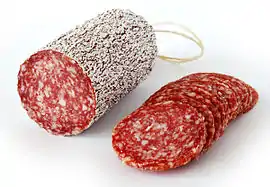

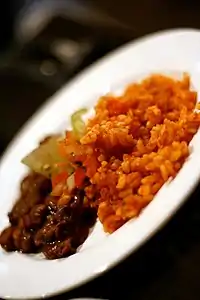

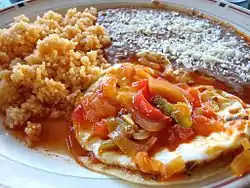
.jpg.webp)
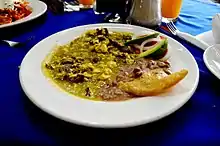

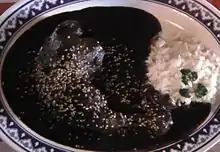

_01.JPG.webp)